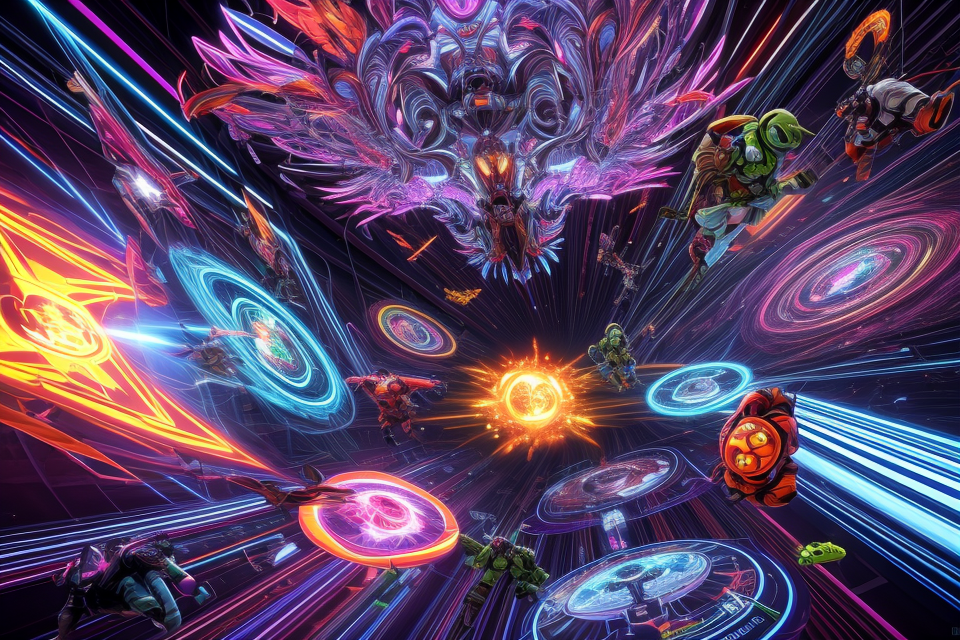Welcome to the exciting world of dynamic gameplay! In today’s modern video games, players are no longer just passive observers; they are active participants in an ever-changing landscape of interactive experiences. But what does it mean for a game to be dynamic? Simply put, dynamic gameplay refers to the game’s ability to change and evolve in response to the player’s actions and decisions. It’s like stepping into a living, breathing world where every choice you make has a ripple effect on the game’s story, characters, and environment. From open-world adventures to multiplayer battle arenas, dynamic gameplay is revolutionizing the way we play and experience video games. So buckle up and get ready to explore the thrilling world of dynamic gameplay!
What is Dynamic Gameplay?
Definition and Key Characteristics
Dynamic gameplay refers to the concept of video games that change and evolve based on the actions and decisions of the player. It is characterized by player agency, which means that the player has a significant impact on the game world and its events. In contrast to static gameplay, where the player’s choices and actions have limited effects on the game, dynamic gameplay allows for a more immersive and interactive experience.
One of the key characteristics of dynamic gameplay is emergent gameplay, which occurs when the player’s actions lead to unexpected and unpredictable outcomes. This can create a sense of unpredictability and excitement, as the player never knows what will happen next. Emergent gameplay can also lead to a greater sense of investment in the game world, as the player feels like they are truly shaping the course of the game.
Another important aspect of dynamic gameplay is the ability to adapt to the player’s skill level and preferences. This can be achieved through various mechanisms, such as adjustable difficulty levels, dynamic difficulty adjustment, and procedurally generated content. By allowing the game to adapt to the player, dynamic gameplay can provide a more personalized and engaging experience.
Overall, dynamic gameplay represents a significant shift in the way video games are designed and played. By empowering the player and creating a more immersive and interactive experience, dynamic gameplay has the potential to revolutionize the video game industry and change the way we play games.
The Importance of Dynamic Gameplay in Modern Video Games
Why dynamic gameplay is crucial for player engagement
In the fast-paced world of modern video games, dynamic gameplay has become an essential component for player engagement. With the increasing complexity of game mechanics and the growing demand for immersive gaming experiences, dynamic gameplay offers a unique and interactive experience for players. It allows players to make choices that have a direct impact on the game’s outcome, making the gaming experience more dynamic and unpredictable.
The impact of dynamic gameplay on replayability and longevity
Dynamic gameplay plays a crucial role in enhancing the replayability and longevity of modern video games. With dynamic gameplay, each playthrough is different, providing players with a unique experience every time they play. This feature encourages players to replay the game multiple times, exploring different paths and making different choices, thereby extending the game’s lifespan. Dynamic gameplay also allows developers to add new content and challenges, keeping the game fresh and exciting for players.
How dynamic gameplay contributes to a more immersive gaming experience
Dynamic gameplay creates a more immersive gaming experience by allowing players to make choices that directly affect the game’s outcome. This feature provides players with a sense of agency and control, making them feel like they are part of the game world. Dynamic gameplay also allows for real-time adaptation to player choices, creating a more personalized gaming experience. This personalization enhances the player’s emotional connection to the game, leading to a more immersive and enjoyable gaming experience.
Examples of Dynamic Gameplay in Action
Dynamic gameplay refers to game mechanics that change or evolve over time, providing players with a more unpredictable and engaging experience. These mechanics can take many forms, but some common examples include:
- Dynamic environments: Games with dynamic environments can change based on player actions, time of day, weather, or other factors. This creates a more immersive and unpredictable experience, as players must always be prepared for unexpected changes.
- Adaptive enemies: Some games feature enemies that adapt to the player’s tactics, becoming harder or easier to defeat depending on how the player approaches them. This creates a more challenging and dynamic gameplay experience, as players must constantly adjust their strategies to overcome their foes.
- Dynamic storytelling: Some games feature narratives that change based on player choices, providing a more personalized and replayable experience. This can lead to a greater sense of investment in the story, as players feel like they are shaping the outcome of the game.
- Dynamic game mechanics: Some games feature mechanics that change or evolve over time, providing players with new challenges and opportunities. This can lead to a more dynamic and engaging experience, as players must constantly adapt to new circumstances.
Here are some case studies of dynamic gameplay in action:
- The Legend of Zelda: Breath of the Wild: This game features a dynamic environment that changes based on player actions, time of day, and weather. Players must be prepared for unexpected changes, such as rain causing slippery surfaces or enemies becoming more aggressive at night.
- No Man’s Sky: This game features adaptive enemies that become harder or easier to defeat depending on the player’s tactics. Players must constantly adjust their strategies to overcome their foes, leading to a more challenging and dynamic gameplay experience.
- Life is Strange: This game features dynamic storytelling that changes based on player choices. Players must make decisions that shape the outcome of the story, leading to a greater sense of investment in the narrative.
- Spelunky: This game features dynamic game mechanics that change over time, providing players with new challenges and opportunities. Players must constantly adapt to new circumstances, leading to a more dynamic and engaging experience.
By analyzing the implementation of dynamic gameplay in popular video games, we can gain a better understanding of how these mechanics can enhance the player experience. However, it is important to compare the benefits and drawbacks of dynamic gameplay mechanics to determine their overall impact on modern video games.
The Evolution of Dynamic Gameplay
Tracing the history of dynamic gameplay in video games
Dynamic gameplay has been a part of video games since their inception, but it has evolved significantly over the years. Early games such as Pong and Space Invaders were simple and did not have much in the way of dynamic elements. However, as technology improved and game design became more sophisticated, dynamic gameplay began to play a more prominent role in video games.
One of the earliest examples of dynamic gameplay was in the game “Colossal Cave Adventure,” which was released in 1976. This game allowed players to explore a cave system and interact with various objects and creatures within it. The game was highly interactive and allowed players to make choices that affected the outcome of the game.
Another early example of dynamic gameplay was in the game “Ultima IV,” which was released in 1985. This game introduced a moral and ethical system that influenced the game’s story and the choices that players could make. The game also had a dynamic world that changed based on the player’s actions.
The key innovations that led to the modern state of dynamic gameplay
The 1990s saw a significant evolution in dynamic gameplay with the release of games such as “Super Mario 64” and “The Legend of Zelda: Ocarina of Time.” These games introduced 3D gameplay and allowed players to explore open worlds with dynamic environments.
One of the most significant innovations in dynamic gameplay was the introduction of procedural generation in games such as “Elite” and “Minecraft.” These games used algorithms to generate levels and environments that were different each time the game was played. This allowed for a high degree of replayability and added a significant level of challenge to the games.
In recent years, dynamic gameplay has become even more sophisticated with the introduction of artificial intelligence and machine learning. Games such as “No Man’s Sky” and “Grand Theft Auto V” use advanced algorithms to create dynamic worlds that respond to the player’s actions. This has allowed for a new level of immersion and realism in video games.
The future of dynamic gameplay and its potential impact on the gaming industry
The future of dynamic gameplay is likely to see even more sophisticated algorithms and artificial intelligence being used to create more realistic and immersive gameplay experiences. As technology continues to advance, we can expect to see even more dynamic worlds that respond to the player’s actions in real-time.
The impact of dynamic gameplay on the gaming industry cannot be overstated. It has allowed for a new level of player interaction and immersion, and has opened up new possibilities for game designers. As dynamic gameplay continues to evolve, we can expect to see even more innovative and exciting games that push the boundaries of what is possible in the world of video games.
Factors That Contribute to Dynamic Gameplay
Player Choice and Agency
Player choice and agency are critical components of dynamic gameplay. They allow players to make meaningful decisions that shape their experience and the game world. Here are some ways in which player choice and agency contribute to dynamic gameplay:
How player choice and agency shape dynamic gameplay
Player choice and agency are essential in creating a sense of immersion and investment in the game world. When players have the ability to make meaningful decisions, they feel more involved in the game and are more likely to be invested in the story and characters. For example, in a game like “The Witcher 3,” players can choose which quests to undertake, which characters to interact with, and how to approach combat situations. These choices have a significant impact on the game world and can lead to different outcomes.
The importance of providing players with meaningful decisions
Providing players with meaningful decisions is crucial for dynamic gameplay. Players want to feel that their choices matter and that they are shaping the game world in some way. This can be achieved by giving players choices that have a tangible impact on the game world, such as changing the outcome of a quest or affecting the relationship between characters. Additionally, providing players with a range of choices can help to create a sense of replayability, as players may want to try different approaches to see how the game world reacts.
Balancing player choice with the game’s overall design
While player choice and agency are essential components of dynamic gameplay, it is also important to balance these choices with the game’s overall design. Games must still have a clear narrative and gameplay mechanics that are balanced and fair. For example, in a game like “Skyrim,” players can choose to play as a mage, a warrior, or a thief, but the game’s mechanics are still designed to ensure that each playstyle is viable and rewarding.
In conclusion, player choice and agency are critical components of dynamic gameplay. They allow players to make meaningful decisions that shape their experience and the game world. However, it is important to balance player choice with the game‘s overall design to ensure that the game remains engaging and fair for all players.
Procedural Generation
Understanding Procedural Generation and its Role in Dynamic Gameplay
Procedural generation refers to the algorithmic process of creating content, such as game levels or assets, using mathematical rules and procedures. This technique has become increasingly prevalent in modern video games, as it allows for the creation of diverse and unique gameplay experiences.
The Benefits and Challenges of Procedural Generation in Game Design
The benefits of procedural generation are numerous. It allows for the creation of virtually endless content, reducing the need for manual level design. It also enables games to adapt to player behavior, providing a more personalized experience. Furthermore, procedural generation can help create a sense of discovery and exploration, as players encounter unexpected gameplay elements.
However, there are also challenges associated with procedural generation. It can be difficult to balance the generated content to ensure a fair and engaging experience for players. Additionally, procedural generation can sometimes lead to repetitive or formulaic gameplay, if not implemented carefully.
Notable Examples of Procedural Generation in Various Genres
Procedural generation has been used in a variety of genres, including action-adventure, roguelike, and simulation games. In action-adventure games, procedural generation is often used to create vast open worlds, filled with diverse environments and enemies. In roguelike games, procedural generation is used to create randomly generated levels, offering a unique challenge each time. In simulation games, procedural generation is used to create realistic cities and landscapes, providing a dynamic and evolving game world.
Adaptive Difficulty
Adaptive difficulty is a game mechanic that adjusts the difficulty of a game in real-time based on a player’s performance. This system aims to provide a more personalized and engaging experience for players by challenging them with a level of difficulty that is just right for them. In this section, we will discuss the concept of adaptive difficulty, its impact on dynamic gameplay, and its advantages and disadvantages.
The Concept of Adaptive Difficulty
Adaptive difficulty systems use various algorithms and data analysis techniques to assess a player’s performance in real-time. This information is then used to adjust the difficulty of the game accordingly. The goal is to provide a challenge that is neither too easy nor too difficult, keeping the player engaged and motivated to continue playing.
The Impact of Adaptive Difficulty on Dynamic Gameplay
Adaptive difficulty systems have a significant impact on dynamic gameplay. By constantly adjusting the difficulty of the game, these systems ensure that players are always challenged at an appropriate level. This means that players can enjoy a more dynamic and engaging experience, as the game adapts to their skills and abilities.
Advantages and Disadvantages of Adaptive Difficulty Systems
Like any game mechanic, adaptive difficulty systems have their advantages and disadvantages. Some of the advantages include:
- Provides a more personalized and engaging experience for players
- Keeps players challenged and motivated to continue playing
- Allows for a more dynamic and responsive gameplay experience
However, there are also some disadvantages to consider:
- May lead to a lack of challenge for more experienced players
- May frustrate players who feel that the game is too easy or too difficult at certain times
- May require significant resources and development time to implement effectively
Case Studies of Successful Adaptive Difficulty Implementations
There are several examples of successful adaptive difficulty implementations in modern video games. For instance, the game “Dark Souls” uses an adaptive difficulty system that adjusts the difficulty of the game based on the player’s performance. This system has been praised for providing a challenging and engaging experience for players. Another example is the game “Minecraft,” which uses an adaptive difficulty system to adjust the difficulty of the game based on the player’s progress. This system has been successful in keeping players engaged and motivated to continue playing.
Multiplayer Interaction
The inclusion of multiplayer interaction in video games has significantly impacted the concept of dynamic gameplay. Multiplayer modes, whether cooperative or competitive, provide players with a more dynamic and interactive experience, as they must consider the actions and decisions of others in addition to their own.
In this section, we will discuss the influence of multiplayer interaction on dynamic gameplay, explore how cooperative and competitive multiplayer modes contribute to dynamic gameplay, and analyze successful multiplayer game designs that incorporate dynamic gameplay elements.
Influence of Multiplayer Interaction on Dynamic Gameplay
Multiplayer interaction in video games adds an extra layer of complexity to the gameplay, as players must consider the actions and decisions of others. This adds an element of unpredictability to the game, as players cannot control the actions of their fellow players. This dynamic element creates a more engaging and challenging experience for players, as they must adapt to the actions of others in order to achieve their goals.
Cooperative and Competitive Multiplayer Modes
Cooperative multiplayer modes, such as in games like Portal 2 or Minecraft, allow players to work together towards a common goal. This creates a more dynamic gameplay experience, as players must coordinate their actions and make decisions based on the needs of the group. Cooperative multiplayer modes also foster a sense of community and teamwork among players, adding to the overall dynamic nature of the game.
On the other hand, competitive multiplayer modes, such as in games like Call of Duty or Overwatch, create a more adversarial dynamic gameplay experience. Players must compete against each other to achieve their goals, adding an element of competition and tension to the game. This type of multiplayer interaction also requires players to adapt to the strategies and tactics of their opponents, creating a more dynamic and unpredictable gameplay experience.
Successful Multiplayer Game Designs
Several successful multiplayer game designs incorporate dynamic gameplay elements through multiplayer interaction. For example, games like League of Legends and Dota 2 utilize cooperative and competitive multiplayer modes to create a dynamic gameplay experience. These games require players to work together and make strategic decisions based on the actions of their teammates and opponents.
Another example is the game Overcooked, which utilizes cooperative multiplayer mode to create a dynamic gameplay experience. In this game, players must work together to prepare and serve meals in a chaotic kitchen, with each player controlling a different character. The dynamic nature of the game comes from the need for players to coordinate their actions and make decisions based on the needs of the group, all while navigating a chaotic kitchen environment.
In conclusion, multiplayer interaction plays a significant role in the dynamic gameplay experience of modern video games. Whether through cooperative or competitive multiplayer modes, players must consider the actions and decisions of others, creating a more engaging and unpredictable gameplay experience. Successful multiplayer game designs incorporate dynamic gameplay elements through multiplayer interaction, providing players with a more dynamic and interactive experience.
The Challenges of Implementing Dynamic Gameplay
Balancing Player Choice and Game Design
One of the most significant challenges in implementing dynamic gameplay is finding the right balance between player choice and the game’s overall design. While allowing players to shape the game world can lead to a more immersive and engaging experience, it can also pose problems for game designers. Here are some of the challenges they face:
- The delicate balance between player choice and the game’s overall design: Game designers must ensure that player choices do not detract from the game’s overall design or theme. For example, a game with a specific narrative may be compromised if players are allowed to make choices that go against the story’s plot or message. Balancing player choice with the game‘s design requires careful consideration of the player’s experience and how their choices impact the game world.
- The challenges of allowing players to shape the game world: When players are given the ability to shape the game world, it can be challenging to ensure that their choices do not have unintended consequences or create imbalances in the game. For example, a game that allows players to build structures may be compromised if players build structures that are too powerful or break the game’s mechanics. Balancing player choice with the game‘s design requires careful consideration of how player choices impact the game world and how to mitigate any potential issues.
- Strategies for creating dynamic gameplay while maintaining a cohesive experience: Game designers must find ways to create dynamic gameplay while maintaining a cohesive experience that stays true to the game’s overall design. This can be achieved through careful consideration of player choices, providing clear guidance on how player choices impact the game world, and designing mechanics that allow for player choice while maintaining balance and fairness. For example, a game that allows players to choose their own path may provide branching narratives that ensure that all player choices lead to a cohesive and satisfying experience.
Technical Considerations
The Technical Hurdles of Implementing Dynamic Gameplay Mechanics
One of the main challenges of implementing dynamic gameplay mechanics is the need for a flexible and adaptable game engine. This requires a high degree of modularity and the ability to integrate new features and mechanics without disrupting the overall game balance. Additionally, dynamic gameplay often requires real-time processing and the ability to respond to player actions in a split second, which can be a significant technical challenge.
The Importance of Scalable and Efficient Game Engines
In order to create dynamic gameplay experiences, game developers need access to scalable and efficient game engines that can handle the complex computations required to create dynamic gameplay mechanics. This requires a deep understanding of computer science and programming concepts, as well as a thorough knowledge of game design principles.
How Game Developers Can Leverage New Technologies to Create Dynamic Gameplay Experiences
Game developers can leverage new technologies such as machine learning and artificial intelligence to create dynamic gameplay experiences. For example, machine learning algorithms can be used to analyze player behavior and adapt the game mechanics in real-time to create a more personalized and engaging experience. Additionally, virtual and augmented reality technologies can be used to create more immersive and dynamic gameplay experiences that respond to player movements and actions in real-time.
Narrative and Pacing
Dynamic gameplay presents unique challenges when it comes to narrative and pacing in video games. In order to create a compelling and coherent story, game developers must carefully balance player choice and agency with the needs of the narrative.
The Relationship between Dynamic Gameplay and Narrative Pacing
Dynamic gameplay can disrupt the traditional narrative pacing of a game, as players are given more control over the story’s progression. This can lead to a more non-linear and unpredictable experience, which may not be suitable for all types of stories.
The Challenges of Incorporating Dynamic Gameplay into Story-Driven Experiences
Incorporating dynamic gameplay into story-driven experiences can be difficult, as it requires a careful balance between player choice and the needs of the narrative. Players must be given enough agency to feel like they are truly in control of the story, while still being guided towards the intended narrative outcome.
Strategies for Maintaining Narrative Coherence while Incorporating Player Choice
One strategy for maintaining narrative coherence while incorporating player choice is to use branching narratives that allow players to make choices that affect the story’s outcome, but still guide them towards the intended conclusion. Another strategy is to use non-linear storytelling techniques, such as flashbacks or multiple perspectives, to create a more cohesive narrative experience.
Overall, the challenges of implementing dynamic gameplay in story-driven experiences require careful consideration of the narrative’s pacing and structure, as well as the need for player agency and control. By balancing these elements, game developers can create dynamic and engaging experiences that still maintain a coherent and compelling story.
The Future of Dynamic Gameplay
Emerging Trends and Innovations
As the gaming industry continues to evolve, new trends and innovations are emerging that are poised to significantly impact the concept of dynamic gameplay.
The Impact of Emerging Technologies on Dynamic Gameplay
Emerging technologies, such as 5G networks and cloud gaming, are set to revolutionize the way dynamic gameplay is experienced. With the increased speed and reliability of 5G networks, players can expect smoother and more seamless gameplay experiences, even on mobile devices. Meanwhile, cloud gaming is allowing players to access games on a wider range of devices, without the need for powerful hardware.
The Role of Artificial Intelligence and Machine Learning in Shaping Dynamic Gameplay
Artificial intelligence (AI) and machine learning (ML) are becoming increasingly important in shaping dynamic gameplay experiences. AI and ML algorithms can be used to create more realistic and responsive non-player characters (NPCs), as well as to generate procedurally generated content that is unique to each player. This creates a more dynamic and personalized gaming experience, where players are constantly faced with new challenges and situations.
The Potential of Virtual and Augmented Reality in Enhancing Dynamic Gameplay Experiences
Virtual reality (VR) and augmented reality (AR) are two technologies that have the potential to significantly enhance dynamic gameplay experiences. VR allows players to fully immerse themselves in a game world, while AR blends digital elements with the real world. These technologies can create more dynamic and interactive gameplay experiences, where players can interact with their environment in new and exciting ways.
Overall, the future of dynamic gameplay looks bright, with new technologies and innovations poised to create more engaging and immersive gaming experiences. As these trends continue to develop, it will be exciting to see how they shape the future of gaming.
The Importance of Balance and Innovation
- The Importance of Striking a Balance
Dynamic gameplay, while offering a fresh and exciting experience for players, must also retain a sense of familiarity to maintain the integrity of the game. The balance between innovation and familiarity is crucial to the success of dynamic gameplay. A game that strays too far from its roots risks alienating its player base, while a game that becomes too stagnant will fail to captivate new audiences.
- The Risks and Rewards of Pushing Boundaries
The gaming industry is constantly evolving, and dynamic gameplay is no exception. Developers must be willing to push the boundaries of what is possible, experimenting with new mechanics and features. However, there are risks involved in this process. Innovative ideas may not always prove successful, and a misstep could result in a failed game. Nevertheless, the rewards of taking risks can be substantial, as a groundbreaking dynamic gameplay feature can set a game apart from its competitors and leave a lasting impact on the industry.
- The Potential Long-Term Impact of Dynamic Gameplay
Dynamic gameplay has the potential to significantly impact the gaming industry and its audience. As more games incorporate this concept, players have come to expect a certain level of interactivity and immersion. This trend towards dynamic gameplay may lead to the development of new genres and gameplay styles, further expanding the possibilities of what video games can offer. Additionally, the success of dynamic gameplay in attracting and retaining players could influence the business models of game developers, with a greater emphasis on creating experiences that evolve over time.
FAQs
1. What does dynamic mean in games?
Dynamic in games refers to the ability of the game environment, characters, and objects to change and adapt in response to player actions and decisions. This can include everything from the behavior of non-playable characters (NPCs) to the layout of the game world itself. In short, dynamic games are ones that are constantly evolving and adapting to the player’s choices, creating a more immersive and engaging experience.
2. How does dynamic gameplay differ from traditional gameplay?
In traditional gameplay, the game world is largely static and predetermined. The player’s actions may have some impact on the game world, but it is limited and usually predefined. In contrast, dynamic gameplay allows for much greater player agency and allows the game world to change and evolve in response to the player’s choices, creating a more unpredictable and exciting experience.
3. What are some examples of dynamic games?
There are many examples of dynamic games, but some of the most popular include open-world games like Grand Theft Auto V and The Legend of Zelda: Breath of the Wild, where the player can explore a vast and changing game world. Other examples include games like Dark Souls and Bloodborne, where the player’s actions can impact the behavior of NPCs and the layout of the game world. And still, others include games like No Man’s Sky and Elite Dangerous, where the game world is constantly changing and evolving based on the player’s actions and decisions.
4. Does dynamic gameplay make games more challenging?
Dynamic gameplay can make games more challenging, as it requires players to adapt to changing situations and make decisions on the fly. However, it can also make games more rewarding and engaging, as players are able to shape the game world and create their own unique experiences. Ultimately, whether or not dynamic gameplay makes a game more challenging will depend on the individual player and their preferences.
5. Are dynamic games more realistic?
Dynamic games are not necessarily more realistic than traditional games, as the level of realism can vary greatly depending on the game’s design and scope. However, dynamic games can create a more immersive and believable game world, as the player’s actions and decisions have a direct impact on the game world and its inhabitants. This can help to create a more realistic and engaging experience for the player.









